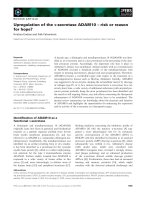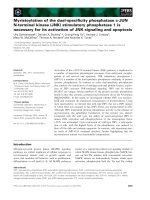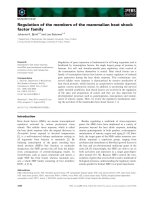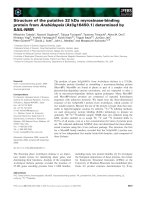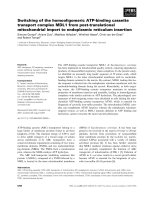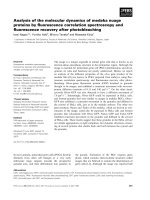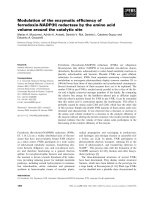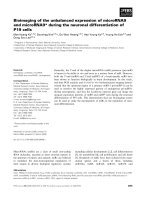Báo cáo khoa học: " Prevalence of Giardia intestinalis and other zoonotic intestinal parasites in private household dogs of the Hachinohe area in Aomori prefecture, Japan in 1997, 2002 and 2007" potx
Bạn đang xem bản rút gọn của tài liệu. Xem và tải ngay bản đầy đủ của tài liệu tại đây (217.42 KB, 4 trang )
JOURNAL OF
Veterinary
Science
J. Vet. Sci. (2009), 10(4), 305
308
DOI: 10.4142/jvs.2009.10.4.305
*Corresponding author
Tel: +81-176-23-4371; Fax: +81-176-23-8703
E-mail:
Prevalence of Giardia intestinalis and other zoonotic intestinal parasites
in private household dogs of the Hachinohe area in Aomori prefecture,
Japan in 1997, 2002 and 2007
Naoyuki Itoh
1,
*
, Kazutaka Kanai
1
, Yasutomo Hori
2
, Fumio Hoshi
2
, Seiichi Higuchi
1
1
1st, and
2
2nd Department of Small Animal Internal Medicine, School of Veterinary Medicine, Kitasato University 23-35-1
Higashi, Towada, Aomori 034-8628, Japan
An epidemiological study on canine intestinal parasites
was undertaken to evaluate changes in the prevalence
among private household dogs from the Hachinohe region
of Aomori prefecture, Japan, in 1997, 2002 and 2007,
using the formalin-ethyl acetate sedimentation technique.
The risk of zoonotic transmission from household dogs to
humans was also discussed. All intestinal parasites detected
in the present study (Giardia intestinalis, Isospora spp.,
Toxocara canis, Ancylostoma caninum, Trichuris vulpis and
Strongyloides stercoralis) showed no changes in prevalence
over the past 10 years based on analysis considering
canine epidemiological profiles. In particular, prevalence
of Giardia intestinalis in dogs under 1 year old, derived
from pet shops/breeding kennels and kept indoors was
unchanged, remaining at a high level of
>
15.0% at each
time point. Toxocara canis also showed no changes in the
group of dogs under 1 year old, bred by private owners
and kept outdoors, and the prevalence was
>
10.0% every
year. The present results indicate that the prevalence of
Giardia intestinalis and other intestinal parasites in private
household dogs has not always decreased, and the potential
for direct parasitic zoonotic transmission from dogs to
humans may be relatively high level, than from the
environment (indoors and outdoors). We recommend
careful surveillance of intestinal parasites and aggressive
use of anthelminthic in private household dogs under
considering the epidemiological factors.
Keywords:
dog, Giardia intestinalis, intestinal parasites,
Isospora spp., Toxocara canis
Introduction
Intestinal parasitic agents are commonly recognized in
dogs as a cause of gastrointestinal disorders [11]. Canine
intestinal parasites have recently become a more important
pathogen for humans, as some parasites, e.g., Giardia (G.)
intestinalis, Toxocara (T.) canis and others, have become
potential public health hazards due to zoonotic transmission
[11]. In particular, private household dogs that have
relatively close contact with humans represent a serious
potential source of direct parasitic transmission. Although
human parasitic diseases are well controlled in Japan,
many people are still contract zoonotic parasites [10].
Epidemiological data from dogs can undoubtedly contribute
to preventing direct zoonotic transmission from dogs to
humans via the control of infectious animals.
In Japan, recent reports have indicated that the prevalence
of intestinal parasites in private household dogs kept in the
same area has declined in comparison with previous years
[1,12-14]. This declining prevalence is probably due to
improved sanitary conditions by pet owners. However, the
epidemiological background is extremely important for
the interpretation of results relating to canine intestinal
parasites, since prevalence differs significantly according
to the profiles of surveyed dogs [3-7]. Unfortunately, previous
long-term surveillance studies in Japan [1,12-14] have
lacked data analysis based on multifactorial considerations
in regard to epidemiological backgrounds. Previous our
reports [3-7] suggest that the considering of high detective
factor may be helpful for the comparison of data among
differentiated studies. The aim of this investigation was to
determine the prevalence of G. intestinalis and other
intestinal parasites (Isospora spp., T. canis, Ancylostoma
(A.) caninum, Trichuris (T.) vulpis and Strongyloides (S.)
stercoralis) in private household dogs of Hachinohe region
in Aomori prefecture, Japan in 1997, 2002 and 2007. Data
were analyzed based on consideration of epidemiological
backgrounds such as canine ages and origin.
306 Naoyuki Itoh et al.
Tab l e 1 . Overall and classified prevalence of canine intestinal parasites in 1997, 2002 and 2007
Parasites
Percentage (%) of detected dogs
1997 2002 2007
Giardia intestinalis
Group 1
a
Others
b
Isospora spp.
Group 1
a
Others
b
Toxocara canis
Group 2
a
Others
b
Ancylostoma caninum
Group 3
a
Others
b
Trichuris vulpis
Group 3
a
Others
b
Strongyloides stercoralis
Group 1
a
Others
b
14.3 (60/420)
23.7 (54/228)
3.1 (6/192)
9.5 (40/420)
c
16.7 (38/228)
1.0 (2/192)
4.3 (18/420)
16.1 (5/31)
3.3 (13/389)
1.0 (4/420)
4.5 (3/67)
0.3 (1/353)
3.8 (16/420)
13.4 (9/67)
2.0 (7/353)
1.4 (6/420)
3.1 (7/228)
1.0 (2/192)
10.9 (38/350)
18.9 (27/143)
5.3 (11/207)
7.4 (26/350)
18.2 (26/143)
0 (0/207)
3.1 (11/350)
12.1 (4/33)
2.2 (7/317)
1.1 (4/350)
6.0 (3/50)
0.3 (1/300)
2.6 (9/350)
8.0 (4/50)
1.7 (5/300)
0.6 (2/350)
1.4 (2/143)
0 (0/207)
11.6 (39/335)
26.2 (34/130)
2.4 (5/205)
4.5 (15/335)
d
11.5 (15/130)
0 (0/205)
3.6 (12/335)
12.5 (4/32)
2.6 (8/303)
1.5 (5/335)
6.1 (3/49)
0.7 (2/286)
1.2 (4/335)
10.2 (5/49)
2.1 (6/286)
1.2 (4/335)
3.1 (4/130)
0 (0/205)
a: high detective factor complex. b: non-high detective factor complex. a vs. b: p < 0.01 or p < 0.05, except for S. stercoralis in 2002. c vs.
d: p < 0.01.
Materials and Methods
Fresh fecal specimens were collected from 420, 350 and
335 private household dogs presented to individual
veterinary clinics regardless of illness history and living in
the Hachinohe area of Tohoku region in Aomori prefecture
of Japan, in 1997, 2002 and 2007, respectively. Hachinohe
is situated in the northern part of Japan, with approximately
300,000 people living in this area. Parasitic agents in stools
were detected using the formalin-ethyl acetate sedimentation
technique as previously described [17]. Obtained data was
analyzed by considering the high detective factor complex
for each parasitic agent, and statistical significance of
results was calculated using Fisher’s exact probability test.
Va l ues o f p < 0.05 were considered significant. Epidemiological
high detective factors for each intestinal parasite of private
household dogs have already been described in our previous
reports [3-7]. Considering the high detective factor is helpful
for the comparison of data among differentiated studies.
Therefore, the concept of a high detective factor complex
was accepted for the evaluation of the results in the present
study. The high detective factor complex for each parasite
in the present study was as follows: Group 1 (G. intestinalis,
Isospora spp. and S. stercoralis) comprised dogs under 1
year old, derived from pet shops/breeding kennels and kept
indoors; Group 2 (T. canis) comprised dogs under 1 year
old, bred by private owners and kept outdoors; and Group
3 (A. caninum and T. vulpis) comprised dogs over 2 years
old, bred by private owners and kept outdoors.
Results
There were no significant changes in the overall prevalence
of individual parasites in the three years except for
Isospora spp. (Table 1). A significant difference (p <
0.01) in Isospora spp. infection was found between 1997
(9.5%) and 2007 (4.5%). In all years, all canine intestinal
parasites examined in the present study (G. intestinalis,
Isospora spp., T. canis, A. caninum, T. vulpis and S.
stercoralis) showed significantly higher (p < 0.05 or p <
0.01, respectively) prevalence in groups with high
detective factor complexes compared to others (non-high
detective factor complex), except for S. stercoralis in 2002.
No parasites in either group of high detective factor
complexes or others revealed any significant difference
related to surveyed years. In particular, the prevalence of
G. intestinalis in the group with a high detective factor
complex was almost unchanged over the 10 years, with high
levels (> 15.0%) were recorded every year. Isospora spp.
and T. canis also had no changes in the high detective factor
complex group, with the prevalence > 10.0% every year.
Prevalence of Giardia and other zoonotic intestinal parasites in dogs 307
Discussion
Until the present study was performed, the authors
believed that the recent regional prevalence of intestinal
parasites in private household dogs had decreased
compared to 10 years ago, since the knowledge of owners
regarding canine intestinal parasites and parasitic
zoonoses has been increased provably. Several papers in
Japan have actually shown that the prevalence of intestinal
parasites in private household dogs had decreased
compared to past years [1,12-14]. Unexpectedly, the
prevalence of all intestinal parasites studied had not
changed over the past 10 years in the present study, when
data was analyzed based on the concept of epidemiological
high detective factor complex. The present results indicate
that profiles in surveyed dogs are important for the
interpretation of data from epidemiological studies on
canine intestinal parasites.
Although the prevalence of Isospora spp. protozoa in the
present study outwardly showed a significant decline
associated with the studied year in terms of overall
prevalence, the real prevalence under the consideration of
epidemiological factors showed no changes. False
interpretations may occur if canine profiles are neglected.
Differentiation of surveyed canine populations may
produce different results, as many factors related to dogs
are mixed, and comparison under identical conditions is
impossible. Data on canine intestinal parasites obtained
without considering canine profiles seems to supply only
limited information, and sometimes induces meaningless
but apparently significant differences among the results.
When zoonoses are discussed, epidemiological backgrounds,
including information of dog-human contact are more
important in public health. Even if the prevalence of
zoonotic parasites in dogs is high, the problem will be
minimal if contact between infected dogs and humans is
infrequent. In contrast, a serious problem is obviously
present for humans if there is frequent close contact, even
if prevalence is low. Certain indicators are needed to
compare epidemiological data on canine intestinal parasites
from differential populations. The concept of high detective
factor complex, which is supported by the results of previous
reports [3-7].
A surprising finding was that the protozoan G. intestinalis
in the high detective factor complex group (under 1 year
old, derived from pet shops/breeding kennels and kept
indoors) recorded a high prevalence continuously over the
past 10 years, with a peak of 26.2% in 2007. Although there
has been no clear evidence of Giardia transmission from
dogs to humans, there have been reports of suspected
human cases of giardiasis from a canine source [2,16].
Moreover, household dogs have the possibility of higher
prevalence of G. intestinalis infection than seen in the
present results. This is because recent previous studies
have demonstrated that enzyme-linked immune absorbent
assay and polymerase chain reaction techniques are more
sensitive to detecting Giardia infection than the
convenient microscopic examination method such as used
in the present study [8,9,15]. However more sensitive
methods were unused in the present study, because the
certain technique was needed to evaluate the prevalence
among the differentiated years. Emphasis should be placed
on the fact that G. intestinalis infected dogs are often in
very close contact with humans, creating a scenario for
direct transmission.
T. canis is most famous nematode among the canine
intestinal parasites, and the potential for zoonotic
transmission is commonly recognized around the world
[11]. Since numerous anthelmintic drugs for T. canis are
sold in pet shops and home centers in Japan, owners are
easily able to obtain and treat their animals. However, the
prevalence in the group with a high detective factor
complex (under 1 year old, bred by private owners and kept
outdoors) has been steady (>10%) over the past 10 years.
The risk of transmission through the contamination of T.
canis eggs in the field has clearly not been reduced in the
area of the present study. The importance of regular fecal
examination in household dogs needs to be recognized
more among owners and clinical veterinarians.
Although S. stercoralis is also a zoonotic nematode [11]
in close contact with humans according to the
epidemiological profile, prevalence has been low over the
past 10 years. S. stercoralis was detected to a limited extent
in dogs derived from pet shops/breeding kennels under 1
year old. This suggests that S. stercoralis transmission may
occur continuously among young dogs in pet shops/breeding
kennels. This finding is similar to Isospora spp. infections,
in that the infected dogs were almost all young dogs from
pet shops/breeding kennels. A. caninum and T. vulpis are
mainly detected in older outdoor dogs, and the prevalence
has not changed over the past 10 years. Contamination of
fields via A. caninum and T. vulpis eggs is suspected to
have contributed to the lack of change in the region of the
present study.
In conclusion, the present results indicate that the
prevalence of G. intestinalis and other intestinal parasites
in private household dogs has not always decreased, and
the potential for parasitic zoonotic transmission from dogs
to humans seems to remain at a higher level than we
initially presumed. We recommend careful surveillance of
intestinal parasites and aggressive use of anthelminthic in
private household dogs under considering the epidemiological
factors.
References
1. Asano K, Suzuki K, Matsumoto T, Sakai T, Asano R.
Prevalence of dogs with intestinal parasites in Tochigi, Japan
308 Naoyuki Itoh et al.
in 1979, 1991 and 2002. Vet Parasitol 2004, 120, 243-248.
2. Eligio-Garc
ía L, Cortes-Campos A, Jiménez-Cardoso E.
Genotype of Giardia intestinalis isolates from children and
dogs and its relationship to host origin. Parasitol Res 2005,
97, 1-6.
3. Itoh N, Itoh S. Survey on nematode in the digestive tract of
adult dogs reared in Hachinohe area, Aomori prefecture. J
Jpn Vet Med Assoc 1999, 52, 649-653.
4. Itoh N, Muraoka N. Detection of Isospora oocysts in
household dogs. J Jpn Vet Med Assoc 2002, 55, 21-25.
5. Itoh N, Muraoka N, Aoki M, Itagaki T. Prevalence of
Giardia lamblia infection in household dogs. Kansenshogaku
Zasshi 2001, 75, 671-677.
6. Itoh N, Muraoka N, Aoki M, Itagaki T. Prevalence of
Strongyloides spp. infection in household dogs. Kansenshogaku
Zasshi 2003, 77, 430-435.
7. Itoh N, Muraoka N, Aoki M, Itagaki T. Prevalence of
Toxocara canis infection in household dogs. Kansenshogaku
Zasshi 2004, 78, 114-119.
8. Itoh N, Muraoka N, Aoki M, Itagaki T. Detection of Giardia
antigen in puppies using enzyme-linked immunosorbent
assay. J Jpn Vet Med Assoc 2004, 57, 579-582.
9. McGlade TR, Robertson ID, Elliot AD, Thompson RCA.
High prevalence of Giardia detected in cats by PCR. Vet
Parasitol 2003, 110, 197-205.
10. Nakamura-Uchiyama F, Hiromatsu K, Ishiwata K,
Sakamoto Y, Nawa Y. The current status of parasitic diseases
in Japan. Intern Med 2003, 42, 222-236.
11. Robertson ID, Thompson RC. Enteric parasitic zoonoses
of domesticated dogs and cats. Microbes Infect 2002, 4,
867-873.
12. Saito T, Hashiguchi M, Shimatani K, Miyano S, Yamaashi
K, Yamaguchi H, Yoshida K, Ikeda F, Kuya M, Utsnomiya
K, Tongu Y. Infection rate of parasites in domestic dogs and
cats in Fukuyama city, Hiroshima prefecture in 2002. J Vet
Med (Tokyo) 2004, 57, 11-14.
13. Saito T, Morishige K, Tongu Y. Parasites of pet dogs and
cats in Fukuyama city. Kisechugaku Zasshi 1995, 44, 149-
153.
14. Saito T, Yamaguchi H, Yoshida K, Kusaura J, Wada E,
Morishige K, Tongu Y.
Infection rate of parasites in domestic
dogs and cats in Fukuyama city in 1995. J Vet Med (Tokyo)
1998, 51, 889-892.
15. Schunk M, Jelinek T, Wetzel K, Nothdurft HD. Detection
of Giardia lamblia and Entamoeba histolytica in stool samples
by two enzyme immunoassays. Eur J Clin Microbiol Infect
Dis 2001, 20, 389-391.
16. Traub RJ, Monis PT, Robertson I, Irwin P, Mencke N,
Thompson RCA. Epidemiological and molecular evidence
supports the zoonotic transmission of Giardia among humans
and dogs living in the same community. Parasitology 2004,
128, 253-262.
17. Young KH, Bullock SL, Melvin DM, Spruill CL. Ethyl
acetate as a substitute for diethyl ether in the formalin-ether
sedimentation technique. J Clin Microbiol 1979, 10, 852-853.


